To prevent wandering in memory care, you should recognize early signs like pacing and curiosity about exits. Create a secure environment by installing lock systems, alarms, and tamper-proof locks on doors. Use technology like sensors, GPS devices, and wearable monitors to keep track of residents. Incorporate clear signage and a safe outdoor space. Proper caregiver training and strong community links further support safety. Keep learning how extensive strategies can protect your loved ones.
Key Takeaways
- Secure entry points with electronic locks, alarms, and tamper-proof systems to prevent unauthorized exits.
- Design environment with clear signage, good lighting, and clutter-free pathways to reduce confusion and facilitate safe navigation.
- Utilize technology like door/window sensors, GPS trackers, and wearable monitors for real-time monitoring and alerts.
- Educate staff on behavioral triggers and implement consistent routines to minimize wandering incidents.
- Establish community partnerships and emergency plans to ensure prompt assistance and a safe response to wandering episodes.
Recognizing Early Signs of Wandering Behavior
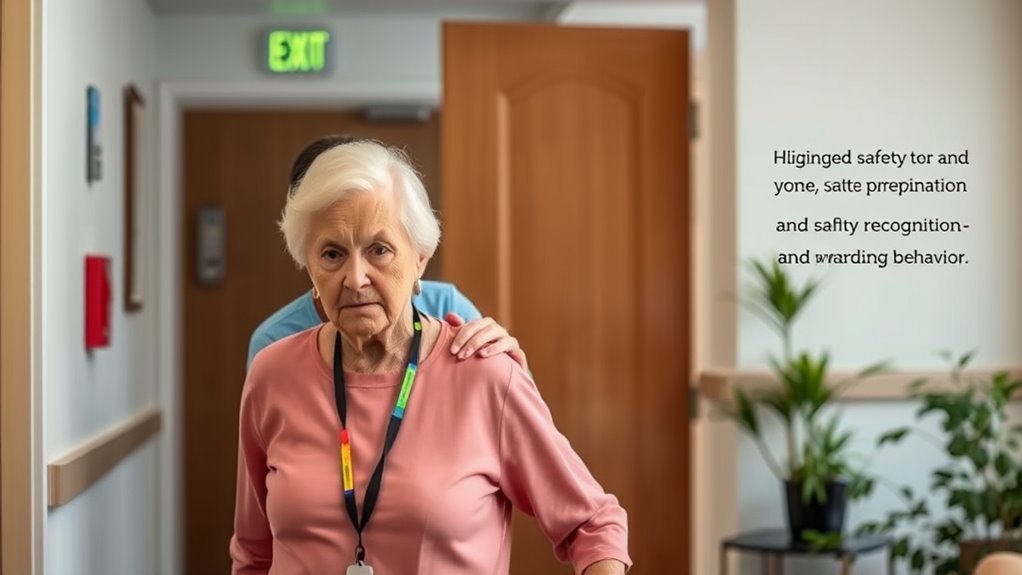
Recognizing early signs of wandering behavior is crucial for ensuring the safety of those with memory issues. Pay attention to behavior triggers that may lead someone to wander, such as restlessness, confusion, or agitation. These signs often indicate distress or discomfort that prompts them to seek an escape. Environmental factors can also influence wandering; cluttered spaces, unfamiliar surroundings, or changes in routine often increase the risk. Notice if your loved one becomes unusually curious about doors, windows, or exits. They might start pacing, repeatedly check certain areas, or show signs of agitation. Being aware of these early indicators helps you intervene proactively, reducing the risk of wandering. Understanding behavioral triggers and how they relate to a person’s environment can help in developing effective safety strategies. Recognizing early warning signs allows caregivers to respond swiftly and prevent potential dangers. Identifying these signs early allows you to plan appropriate safety measures and address underlying issues before wandering occurs, especially considering that environmental interactions significantly impact these behaviors. Additionally, consulting with healthcare professionals about individual risk factors can further enhance safety planning.
Creating a Safe and Secure Living Environment
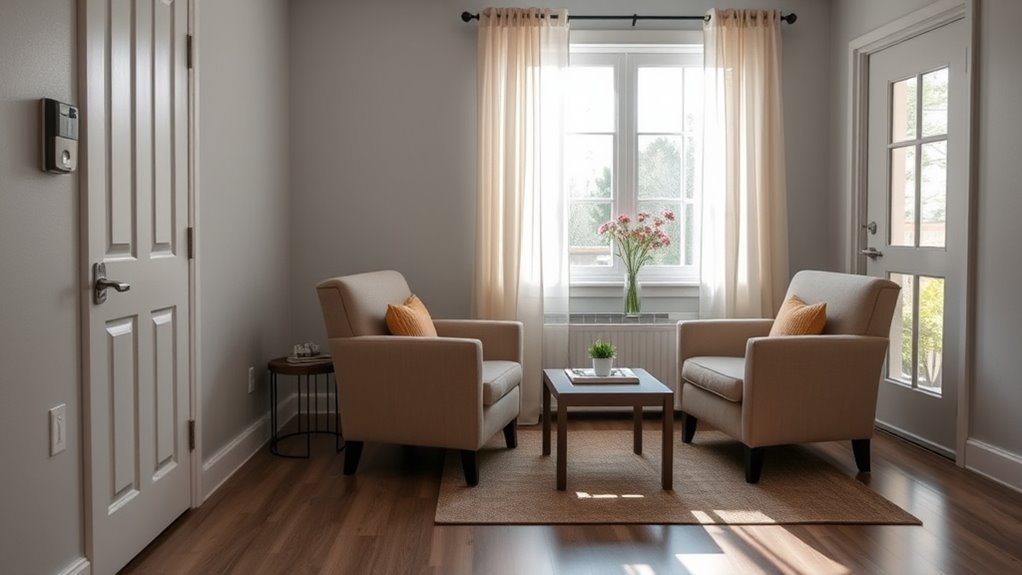
You can help prevent wandering by securing all entry points and installing alarms on doors. Make sure signage is clear and lighting is ample to guide residents safely through your space. Additionally, arrange your indoor layout to minimize hazards and create a comfortable, safe environment. Incorporating local safety tips can further enhance your efforts to ensure resident security. Being aware of aviation regulations related to safety measures can also provide valuable insights into maintaining a secure environment. Regular staff training on emergency procedures ensures prompt responses to any incidents and reinforces overall safety protocols. Recognizing behavioral indicators can help staff identify residents at risk of wandering before incidents occur. Paying attention to contrast ratio in lighting design can improve visibility and reduce confusion for residents.
Secure Entry Points
How can you guarantee that entry points in a memory care facility are both accessible for residents and secure against wandering? Start by implementing strong home security measures, such as lock systems that require key code access or electronic key cards, to control who enters and exits. Incorporate visitor management protocols, like sign-in sheets or visitor badges, to monitor everyone coming into the building. Consider installing alarms on doors that are easily accessible to residents but trigger alerts if opened unexpectedly. Use secure, tamper-proof locks and ensure staff are trained to oversee entry and exit points consistently. Additionally, utilizing security measures can further enhance safety and prevent unauthorized access. These steps help create a safe environment where residents can move freely without the risk of wandering, while still allowing trusted visitors easy access.
Implementing attention and vigilance is also crucial for staff to promptly respond to any unusual activity around entry points, thereby further reducing risks.
Clear Signage and Lighting
Effective signage and lighting are essential for creating a safe and secure environment in a memory care facility. Clear visual cues help residents navigate spaces confidently, reducing confusion and frustration. Use high-contrast colors and simple symbols as wayfinding aids to guide residents toward exits, dining areas, and bathrooms. Proper lighting eliminates shadows and dark spots that can cause disorientation or falls, especially at night. Ensure hallways are well-lit and signage is placed at eye level for easy visibility. Consistent, straightforward signs help residents recognize familiar places and understand their surroundings. Incorporating environmental cues can further support residents’ wayfinding and orientation. Additionally, integrating automation technologies can optimize lighting and signage systems for better adaptability and responsiveness, enhancing safety. By combining effective lighting with clear, strategic signage, you create an environment that promotes independence while minimizing wandering risks. This approach supports residents’ safety and enhances their overall well-being.
Safe Indoor Layout
Designing a safe indoor layout involves arranging spaces thoughtfully to minimize hazards and promote easy navigation. You should prioritize furniture arrangement by keeping pathways clear and avoiding clutter that could trip or confuse residents. Use sturdy, stable furniture with rounded edges to prevent injuries. Incorporate decorative accents strategically to enhance visual appeal without creating obstacles or distractions. Avoid overcrowding rooms and keep essential areas, like bathrooms and exits, easily accessible. Consider color contrasts to help residents distinguish different spaces and furniture. Secure rugs with non-slip backing and eliminate cords or loose wires from walkways. Regular maintenance and cleaning of the environment helps reduce dust and debris that could affect residents’ health. Additionally, installing adequate lighting further enhances safety by reducing shadows and improving visibility. Clear sightlines can also be achieved by thoughtful furniture placement, allowing residents and caregivers to easily monitor activity. Implementing technology solutions such as sensors or alarms can further prevent wandering incidents and alert caregivers promptly. Ensuring that furniture placement facilitates clear sightlines can also help residents feel more secure and monitored. A well-planned layout not only reduces the risk of wandering-related accidents but also fosters a sense of comfort and familiarity, making residents feel more secure in their environment.
Installing Effective Door and Window Alarms
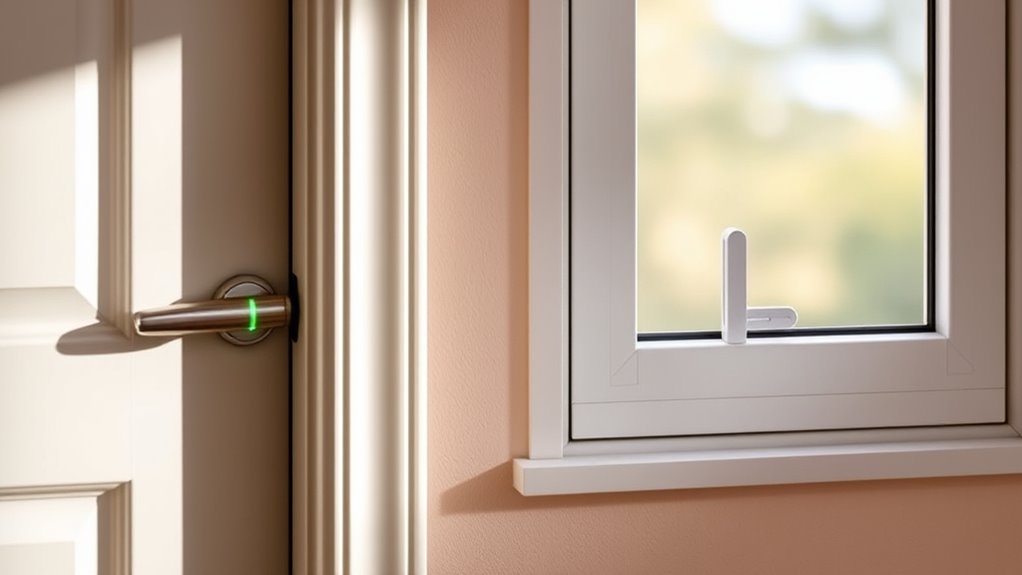
Choosing the right sensor types and placement is vital for effective door and window alarms. You need to think about where to install sensors so they detect movement without false alarms. Additionally, integrating these alarms with your existing security system guarantees a seamless approach to keeping your loved ones safe. For a more resilient setup, consider using low light office plants that require minimal maintenance and won’t interfere with sensor operation. Proper sensor placement and understanding sensor sensitivity help minimize false alarms and ensure timely alerts. Being aware of privacy policies ensures your system complies with data protection standards while maintaining safety. Moreover, understanding lifestyle factors can help you tailor your safety measures to better suit your loved ones’ routines and needs.
Sensor Types and Placement
To guarantee reliable detection of wandering, selecting the right sensors and placing them correctly is vital. Start by choosing sensors suited for door and window alarms, such as magnetic reed switches or infrared motion sensors. Proper sensor placement ensures they respond accurately when a door or window opens unexpectedly. Install sensors at the appropriate height and position them to cover the entire opening, avoiding obstructions. Regular sensor calibration is essential; check and adjust settings to prevent false alarms or missed detections. Make sure sensors are securely attached and tested frequently to confirm they activate reliably. By paying close attention to sensor placement and calibration, you create an effective safety system that detects wandering early, enhancing the safety of memory care residents.
Alarm System Integration
Installing effective door and window alarms is a essential step in integrating your safety system, as they serve as the primary alerts when a resident attempts to wander. These alarms can be connected to your home automation system, ensuring instant notifications. When triggered, caregiver alerts are sent immediately, allowing quick intervention. Choose alarms that are easy to activate and monitor, and place them strategically on all exits. Consider systems that sync with smartphones or central control panels for seamless management. Proper integration reduces response time and enhances safety. Use the table below to compare alarm features:
| Feature | Benefit |
|---|---|
| Wireless connectivity | Easy installation and flexible placement |
| Real-time alerts | Prompt caregiver notifications |
| Compatibility with home automation | Streamlined control and monitoring |
| Loud sirens | Deters wandering and alerts others |
Using Technology to Monitor and Track Movement
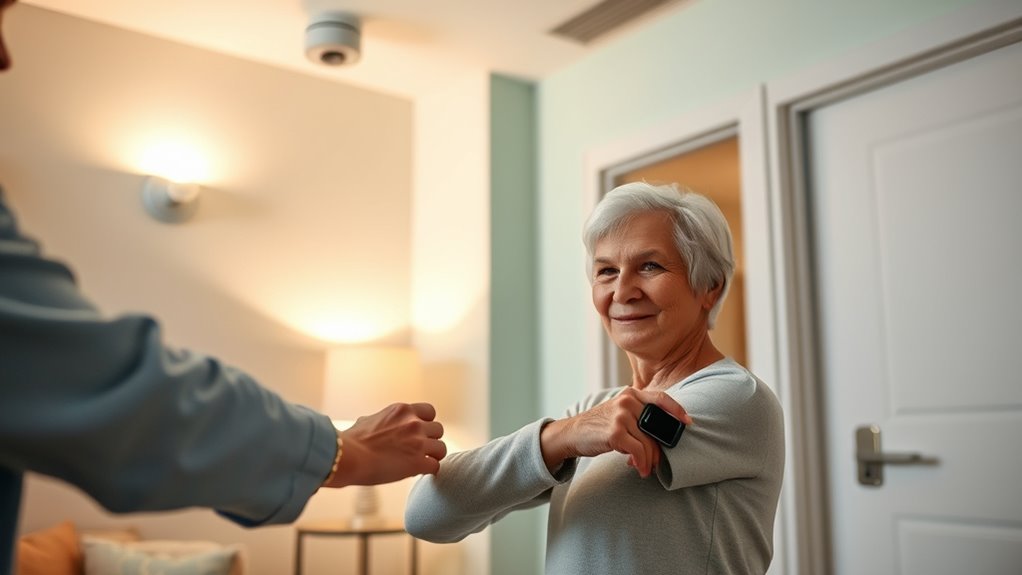
Technology offers effective tools to monitor and track movement, providing peace of mind for caregivers and ensuring safety for residents. GPS tracking and wearable monitors allow you to keep real-time tabs on your loved one’s location, reducing the risk of wandering. These devices can alert you immediately if a resident leaves a designated safe zone, enabling quick response. Wearable monitors are discreet and comfortable, making them suitable for everyday use. They often include features like activity logs and geofencing, enhancing safety and oversight. Using these technologies minimizes the need for constant physical supervision while ensuring prompt intervention when necessary. Staying proactive with GPS tracking and wearable monitors helps you safeguard your loved one and foster independence safely.
- Real-time location updates
- Geofencing alerts for boundary breaches
- Discreet, comfortable wearable monitors
Implementing Identification Devices and Accessories

Choosing the right identification devices is essential for keeping your loved one safe. Make sure the device is placed properly and fits comfortably to prevent irritation or loss. When selecting accessories, consider options that are discreet yet effective for easy identification.
Types of Identification Devices
When it comes to ensuring the safety of individuals with memory impairments, using the right identification devices can make a significant difference. There are various options designed to quickly identify and locate your loved one if they wander. Wearable tech, like wristbands or necklaces, can display important medical info and contact details. RFID tags are discreet, embedded in bracelets or clothing, allowing staff to scan and get instant identification. Some devices also include GPS trackers for real-time location updates. Choosing the right type depends on your loved one’s needs and comfort. It’s crucial to select devices that are durable, easy to use, and non-intrusive. Properly implemented, these tools provide peace of mind and enhance safety during vulnerable moments.
- Wearable tech like ID bracelets or necklaces
- RFID tags embedded in clothing or accessories
- GPS-enabled devices for real-time tracking
Proper Device Placement
Proper equipment positioning is essential to guarantee that identification tools are effective and comfortable for your loved one. You need to verify the device is visible, secure, and accessible without causing discomfort. Caregiver awareness of where and how to place these devices increases safety and reduces wandering risks. Consider placing wristbands or pendants on the wrist or neck, where they won’t easily fall off or be hidden. Use the following table to guide placement:
| Placement Area | Tips |
|---|---|
| Wrist | Secure snugly but not too tight |
| Neck | Use adjustable, breakaway accessories |
| Waist | Attach to belts or clothing |
| Shoe | Use as an alternative if other options fail |
Consistent device placement improves caregiver awareness and response time, ensuring your loved one’s safety.
Ensuring Device Comfort
Ensuring that identification devices and accessories are comfortable for your loved one is vital for ongoing safety and cooperation. When devices fit well and feel comfortable, your loved one is more likely to wear them consistently, reducing the risk of wandering. Choose comfortable wearable devices made from soft, lightweight materials to prevent irritation. User-friendly alert systems should be easy to activate and operate, guaranteeing quick responses if needed. Proper fit prevents chafing or discomfort, encouraging daily use. Remember, comfort promotes compliance, making safety measures more effective.
- Select soft, adjustable straps for a snug but gentle fit
- Opt for lightweight and breathable materials
- Guarantee alert systems are easy for your loved one to wear and understand
Establishing Routine and Supervision Strategies
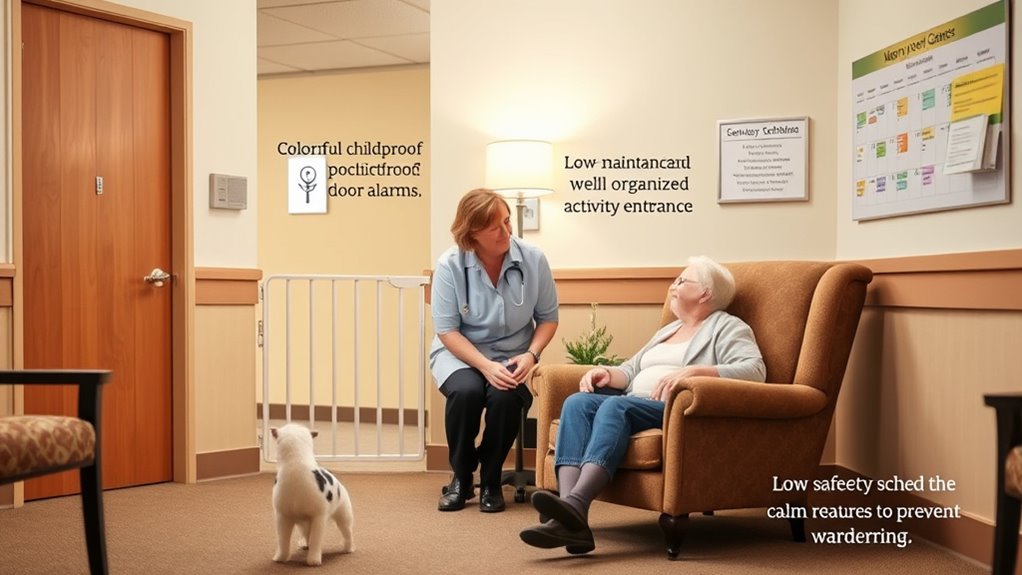
Establishing a consistent routine is one of the most effective ways to reduce wandering in memory care residents. Daily routines provide familiarity and a sense of security, helping residents feel more settled and less inclined to wander. To support this, develop predictable schedules for meals, activities, and rest times. Incorporate supervision strategies by monitoring residents closely, especially during transitional periods or in unfamiliar settings. Keep an eye on residents’ behavior and be alert for signs of confusion or agitation that might trigger wandering. Use visual cues and clear signage to guide residents and reinforce their daily routines. Consistent routines combined with attentive supervision create a structured environment that minimizes the likelihood of wandering and enhances overall safety.
Training Caregivers and Family Members

Training caregivers and family members is essential for preventing wandering and ensuring resident safety. Proper education helps you understand behavior management techniques, recognize early warning signs, and respond effectively. This reduces caregiver stress and improves overall safety. Well-trained individuals can implement intervention strategies quickly, minimizing the risk of residents wandering. You’ll learn how to create calm environments and handle challenging behaviors confidently. Additionally, training emphasizes the importance of consistent routines and communication. With this knowledge, you can better support your loved ones and reduce anxiety for everyone involved. Investing in education guarantees that everyone is prepared to manage risks and maintain a safe, secure environment for residents with memory impairments.
- Understanding behavior management techniques
- Recognizing early wandering signs
- Reducing caregiver stress through effective response
Designing a Safe Outdoor Space

Creating a safe outdoor space for residents with memory impairments involves thoughtful design that minimizes hazards and promotes independence. Focus on landscape aesthetics by choosing natural elements like shrubs, trees, and grassy areas that create a welcoming environment. Incorporate secure fencing that blends seamlessly with the landscape to prevent wandering without feeling restrictive. Use curved pathways to discourage residents from feeling trapped and to reduce the risk of falls. Avoid sharp corners, and ensure surfaces are slip-resistant. Natural elements like water features or sensory gardens can soothe residents and encourage exploration safely. Keep clutter minimized and maintain clear sightlines for staff and caregivers. A well-designed outdoor space balances safety with beauty, helping residents enjoy the outdoors confidently and comfortably.
Communicating With Community Resources and Support Networks

A well-designed outdoor space plays a pivotal role in supporting residents’ independence, but guaranteeing their safety also depends on effective communication with community resources and support networks. Connecting with local agencies and support groups ensures you stay informed and prepared to respond to wandering incidents. Establish clear lines of communication with community outreach programs that specialize in memory care. Regularly update contact lists and share essential information with staff and caregivers. Engage with support groups to learn best practices and gain emotional support. Building strong relationships with community resources helps create a safety net, ensuring residents receive prompt assistance when needed. Staying proactive in communication keeps everyone aligned and enhances overall safety for those with memory impairments.
Developing Emergency Response Plans
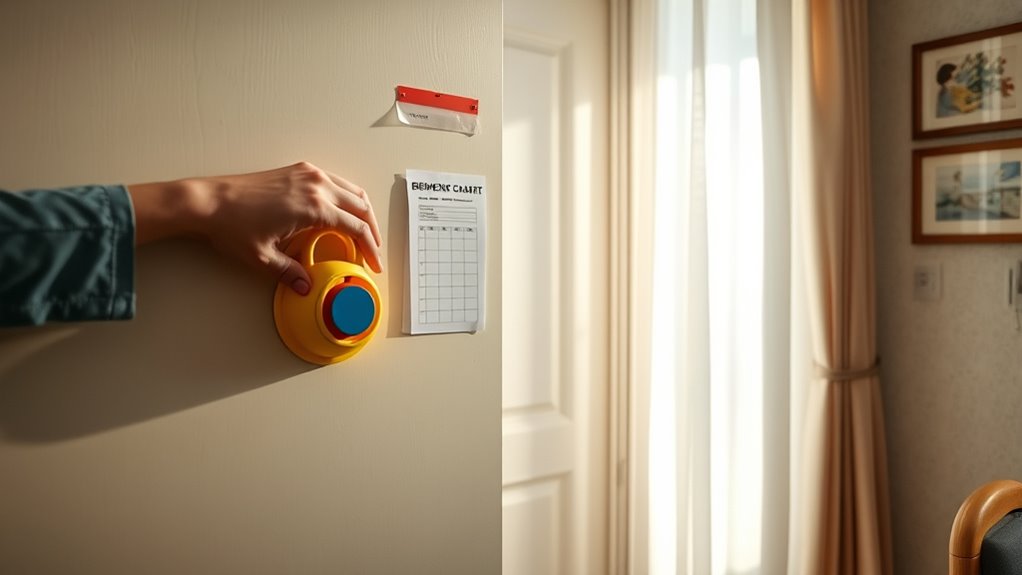
Developing a thorough emergency response plan is vital for guaranteeing quick and effective action when a resident wanders. Start with a comprehensive risk assessment to identify potential wandering triggers and vulnerable areas. This helps tailor your plan to your facility’s specific needs. Proper staff training is essential; everyone must know their role during an emergency, from locating the resident to notifying authorities. Use this table to clarify responsibilities:
| Role | Action Steps | Communication Protocol |
|---|---|---|
| Staff Members | Search, notify, assist resident | Use predefined alerts |
| Supervisors | Coordinate response, update team | Maintain communication logs |
| Management | Review plan, train staff regularly | Ensure compliance |
A well-developed plan minimizes risks and guarantees everyone responds swiftly, keeping residents safe.
Frequently Asked Questions
How Can I Prevent Wandering Before Signs Appear?
To prevent wandering before signs appear, you should start with proactive behavior monitoring. Keep an eye on subtle changes in your loved one’s routines or mood. Make environmental modifications like installing locks or alarms, and create safe, familiar spaces that reduce confusion. Regularly assess their environment and habits, and address concerns early. This proactive approach helps minimize risks and keeps your loved one safe, even before wandering behaviors become evident.
Are There Specific Safety Devices for Outdoor Areas?
Of course, you want outdoor security devices that make your loved one feel like a secret agent. Safety barriers and outdoor security systems are your best friends here. They’ll keep wandering at bay while giving you peace of mind. Think tall fences, lockable gates, and motion-activated alarms. It’s like building a fortress—only friendlier—so your loved one can enjoy the outdoors safely without turning your yard into a high-security prison.
How Do I Involve Neighbors in Safety Planning?
You can involve neighbors in safety planning by fostering community engagement and open neighbor communication. Start by introducing your loved one’s needs and explaining how they can help keep them safe. Share safety tips and establish clear roles for assistance, like monitoring outdoor areas or alerting you if your loved one wanders. Building strong relationships encourages neighbors to stay vigilant and collaborate effectively, creating a safer environment for everyone.
What Legal Considerations Exist for Using Tracking Devices?
When considering tracking devices, you need to guarantee legal compliance and address privacy concerns. You should inform your loved one and obtain their consent, respecting their rights. Check local laws regarding surveillance and data protection, and choose devices that prioritize privacy. Always document your decision-making process and ensure the device is used responsibly, balancing safety with respect for individual privacy rights.
How Can I Balance Safety With Resident Independence?
Did you know that person-centered care profoundly reduces wandering incidents? You can balance safety with resident independence by focusing on individual preferences and needs. Staff training is essential—teaching staff to recognize early signs of wandering and respond appropriately encourages autonomy while maintaining safety. By fostering trust and understanding, you help residents feel secure and respected, creating a supportive environment where independence is preserved without compromising their well-being.
Conclusion
By staying attentive to early signals and creating a nurturing environment, you can gently guide your loved one through their journey. Thoughtful safety measures act as comforting safeguards, helping prevent unwanted adventures. Remember, you’re not alone—support networks and community resources are there to lend a hand. With careful planning and compassion, you can foster a sense of security, ensuring their days remain peaceful and filled with warmth, even during life’s unpredictable moments.









